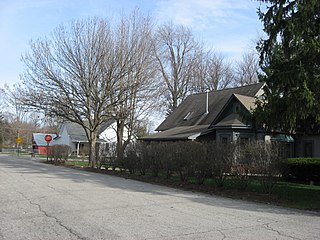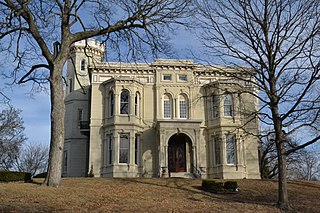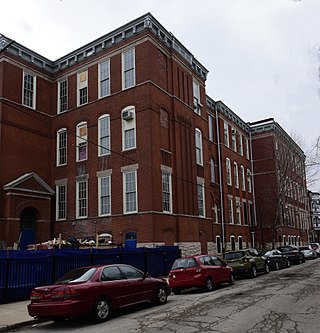
Edgewater is a lakefront community area on the North Side of the city of Chicago, Illinois six miles north of the Loop. The most recently established of the city's 77 official community areas, Edgewater is bounded by Foster Avenue on the south, Devon Avenue on the north, Ravenswood Avenue on the west, and Lake Michigan on the east. Edgewater contains several beaches for residents to enjoy. Chicago's largest park, Lincoln Park, stretches south from Edgewater for seven miles along the waterfront, almost to downtown. Until 1980, Edgewater was part of Uptown, and historically it constituted the northeastern corner of Lake View Township, an independent suburb annexed by the city of Chicago in 1889. Today, Uptown is to Edgewater's south, Lincoln Square to its west, West Ridge to its northwest and Rogers Park to its north.

The Lutheran School of Theology at Chicago (LSTC) is a seminary of the Evangelical Lutheran Church in America in Chicago, Illinois. LSTC is a member of the Association of Chicago Theological Schools (ACTS), a consortium of eleven area seminaries and theological schools. It shares the JKM Library and portions of its campus with McCormick Theological Seminary. LSTC is accredited by the Association of Theological Schools and regionally accredited by the Higher Learning Commission.

St. Peter's Evangelical Lutheran Church, or Iglesia Luterana San Pedro, is a historic church complex located in the Walker's Point neighborhood of Milwaukee, Wisconsin. Its buildings are listed on the National Register of Historic Places.

As of 2007 there are five church buildings in the Sycamore Historic District, located in Sycamore, Illinois, United States which are listed as contributing properties to the district. The Sycamore Historic District was added to the U.S. National Register of Historic Places on May 2, 1978. When it was nominated to join the National Register there were seven church buildings within the district. One of those included is a residential structure that was utilized as a church when it was first constructed; the Arthur Stark House was once home to the Sycamore Universalist Church congregation. In the time since its listing, two churches have been destroyed or demolished. The Evangelical Lutheran Church of St. John was destroyed by fire in 2004 and the United Methodist Church in Sycamore is no longer extant, replaced by a modern office building.

The Noble–Seymour–Crippen House is a mansion located at 5624 North Newark Avenue in Chicago's Norwood Park community area. Its southern wing, built in 1833, is widely considered the oldest existing building in Chicago. As well as the 22nd oldest in the state of Illinois.

The West Jackson Boulevard District in Chicago, Illinois, also known as West Jackson Historic District, was listed on the National Register of Historic Places in 1978. It was earlier designed as a Chicago Landmark, in 1976, and expanded as Jackson Boulevard District and Extension in 1997. The NRHP district was expanded in 1989 to include one more building, the James H. Pearson House.
St. John of Rila in Chicago, is a historic church of the Orthodox Church of America located in Chicago, Illinois. It is considered to be one of the most aesthetically noteworthy churches in the Portage Park area of Chicago.

The Historic Trinity Lutheran Church is a church located in downtown Detroit, Michigan. It occupies the Trinity Evangelical Lutheran Church complex, located at 1345 Gratiot Avenue. It was designated a Michigan State Historic Site in 1981 and listed on the National Register of Historic Places in 1983. Its current pastor is Rev. Darryl L. Andrzejewski.

The German Evangelical Lutheran Church of St. Mark is an historic former church and current synagogue building located at 323 East 6th Street between First and Second Avenues in the East Village neighborhood of Manhattan, in New York City, New York, United States.

The Dundee Township Historic District is a set of sixty-five buildings in Dundee Township, Kane County Illinois. Buildings in the district are found in East Dundee, West Dundee, and Carpentersville. The district represents the development of the upper Fox River Valley from 1870 to the 1920s. Dundee Township became an important industrial area, especially following the construction of the Dundee Brick Company in West Dundee and the Illinois Iron and Bolt Company in Carpentersville. Also included in the district are a variety of Queen Anne, Italianate, and Greek Revival style houses and Gothic Revival churches. The majority of the historic district lies within the boundaries of West Dundee. It was added to the National Register of Historic Places in 1975.

St. Vincent DePaul Catholic Church is a complex of historic buildings in the Shelby Park neighborhood of Louisville, Kentucky. The main church at 1207 South Shelby Street was purchased by Sojourn Community Church in 2010, which has since rehabilitated and occupied it as Sojourn Midtown. Several related properties were listed on the National Register of Historic Places in 1984.

Ravenswood "Old Town" Historic District is a national historic district located at Ravenswood, Jackson County, West Virginia. It encompasses 313 contributing buildings and two contributing structures, the Ohio River Rail Road Steel Pratt-through truss Bridge and Concrete bridge on State Route 68 over Sandy Creek. It includes the commercial and civic core of the town, and surrounding residential buildings. It includes example of popular architectural styles of the mid- to late-19th and early-20th century, including Greek Revival, Gothic Revival, Queen Anne, Colonial Revival, Italianate, Craftsman, and Bungalow. Notable buildings include the McIntosh Building, First Baptist Church, Randolph Building/Caldwell Building (1907), the Grace Episcopal Church ; Our Savior Evangelical Lutheran Church, Ravenswood Community Center (1938), and McIntosh House.

Sheldahl First Norwegian Evangelical Lutheran Church is a historic building located in Sheldahl, Iowa, United States. The community was platted by Osmund Sheldahl and J.S. Polk. Sheldahl was a lay Lutheran minister who settled in Illinois in 1845. He and three others came to this area in 1854 in search of cheap available land. The following year, 21 families that had organized themselves as the "Palestine Congregation" relocated to Story County. Sheldahl became a large land owner and the regular pastor for Palestine Lutheran Church in 1860. He built a house in town in 1877 and he and his two sons built this church building in 1883. Osmund Sheldahl served the congregation as an unpaid pastor for 13 years. His will stipulated that the church building be made available to any Christian denomination that emphasized Bible teaching. It remained in regular use until 1936.

Located in Chesterton, Indiana, the Chesterton Residential Historic District is located a block south of the business district, along Second Street from Indiana Ave. to Lincoln Ave. and on Indiana Ave. from Second to Third Streets. The area began with the Martin Young House construction about 1870. The Historic Landmarks Foundation of Indiana describes as one of the best Italianate structures remaining in northwest Indiana. Most of the structures date from the early twentieth century. St. Patrick's Catholic Church, built in 1876, and burned ca. 2000.

St. John's Lutheran Church is located in rural Franklin County, Iowa, United States, west of the city of Hampton. The church property was listed as a historic district on the National Register of Historic Places as St. John's Danish Evangelical Lutheran Church in 2015. At the time of its nomination it contained ten resources, which included five contributing buildings, two contributing sites, one contributing structure, one contributing object, and one non-contributing structure.

New Augusta Historic District is a national historic district located at Indianapolis, Indiana. It encompasses 114 contributing buildings, 1 contributing structure, and 1 contributing object in a railroad oriented village in Indianapolis. The district developed between about 1852 and 1939, and includes representative examples of Italianate and Bungalow / American Craftsman style architecture. Notable contributing buildings include the Odd Fellows Building, Hopewell Evangelical Lutheran Church, Salem Lutheran Church (1880), and New Augusta Depot. It is located west of Augusta.

Holy Rosary–Danish Church Historic District, also known as Fletcher Place II, is a national historic district located at Indianapolis, Indiana. The district encompasses 183 contributing buildings in a predominantly residential section located in the central business district of Indianapolis. It was developed between about 1875 and 1930, and include representative examples of Italianate, Gothic Revival, Tudor Revival, and Renaissance Revival style architecture. Located in the district is the separately listed Horace Mann Public School No. 13. Other notable buildings include the John Kring House, Trinity Danish Evangelical Lutheran Church (1872), John Wands House (1857), Henry Homburg House, Samuel Keely House, Maria Wuensch Cottage, and Holy Rosary Catholic Church (1911-1925).

Museum Hill Historic District is a national historic district located at St. Joseph, Missouri. The district encompasses 248 contributing buildings in a predominantly residential section of St. Joseph. It developed between about 1860 and 1942, and includes representative examples of Italianate, Second Empire, Queen Anne, Tudor Revival, American Foursquare, and Bungalow / American Craftsman style architecture. Located in the district is the separately listed Robidoux School. Other notable buildings include the First Congregational Church (1890), Francis Street Methodist Church (1905), First Baptist Church (1896) designed by architect Edmond Jacques Eckel (1845–1934), United Presbyterian Church (1901), First Church of Christ Scientist (1905), First English Evangelical Lutheran Church (1913), and Queen of the Apostles Roman Catholic Church (1908) designed by Eckel.

Washington Residential Historic District is a nationally recognized historic district located in Dubuque, Iowa, United States. It was listed on the National Register of Historic Places in 2015. At the time of its nomination it consisted of 327 resources, which included 262 contributing buildings, 61 non-contributing buildings, and two non-contributing objects. This is one of the early residential areas of Dubuque, and was home to its German community. It also defines the "walkable city" with commercial, industrial, and institutional buildings located here. There are a number of churches in the district from various denominations. Of particular interest are St. Mary's Catholic Church (1866), St. John's Lutheran Church (1880), and St. Matthew's Lutheran Church (1908). A significant number of the buildings were constructed in brick, and the vast majority of the buildings in the district were built by 1891. Vernacular structures are commonplace here, as are various Victorian styles. Hollenfelz House (1891) and the Dubuque Casket Company building (1894) are individually listed on the National Register. The former St. Mary's Catholic Church complex forms its own historic district within this one.

The John Lothrop Motley School is a historic school building at 739 N. Ada Street in the West Town neighborhood of Chicago, Illinois. It was built in 1884 to serve the growing neighborhood, as an influx of immigrants and Illinois' 1883 Compulsory Education Law had greatly increased its student population. John J. Flanders, who became chief architect of the Chicago Board of Education in 1884, designed the school according to a standardized plan which was used throughout the city. The Renaissance Revival school has an asymmetrical layout and includes several small side entrances, ornamental brickwork on its chimneys, and a metal cornice. Flanders' design was a stark change from the symmetrical Italianate plans of earlier Chicago public schools. The district's student population continued to increase in the following decades, and the Board of Education built an addition onto the school in 1898 as a result. The school operated continuously until closing in 2013.






















